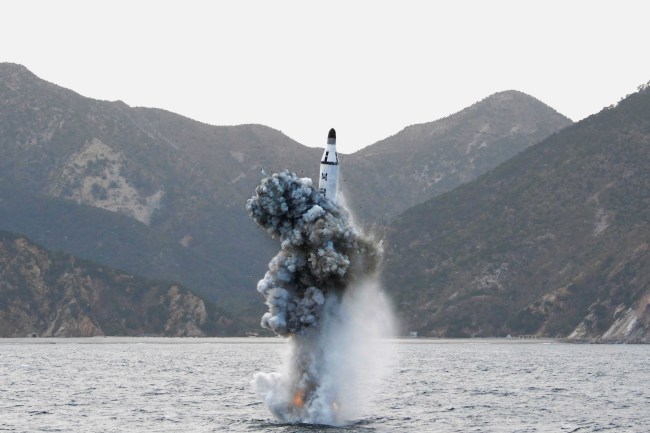North Korea on Wednesday test-fired a submarine-launched ballistic missile into the East Sea, in what appears to be an act of protest against the ongoing annual joint drills held by South Korea and the US.
The launch comes two days after the North threatened “preemptive nuclear strike” against the allies, for what it claims to be a retaliatory action against the military exercise.
According to the Joint Chiefs of Staff, the SLBM was fired around 5:30 a.m. near the city of Sinpo, South Hamkyung Province. It added that the missile appears to have fallen in Japan’s air defense identification zone.

(Yonhap)
“The SLBM appears to have flown about 500 kilometers, which would indicate progress compared to past few test flights,” the JCS said, adding the allies are conducting a detailed analysis of the launch.
“The North’s SLBM launch today -- after it had already fired a missile on July 9 -- appears to be an attempt to drive up the tension in the Korean Peninsula while using the joint drills as an excuse. The military sternly warns (North Korea) that the SLBM launch poses a grave challenge against the security of the peninsula, and is a severe violation of the UN Security Council resolution. We will react with a firm hand against any provocations by the North,” the military said.
The UNSC resolution bans Pyongyang from developing any ballistic missiles or nuclear programs. In March, the UNSC adopted a new resolution that encompasses the strongest economic sanctions to date against the North.
Cheong Wa Dae subsequently convened a National Security Council meeting on 7:30 a.m., to discuss follow-up measures to the launch. The meeting was presided by Kim Kwan-jin, chief of the National Security Office under the presidential office, and reportedly discussed corresponding military and diplomatic actions.
Earlier in the month, North Korea launched two intermediate-range ballistic missiles into the East Sea, one of which landed in Japan’s exclusive economic zone. It was assessed to be a show of force against the allies’ decision last month to deploy the Terminal High Altitude Area Defense system here against the Pyongyang’s ballistic missile threats.
Japan had said that the missile launch presented a severe threat to its security, and vowed to work with South Korea and the US in response.
Since Monday, South Korea and the US has been carrying out the Ulchi Freedom Guardian drills that will continue until Sept. 2. It is one of the annual joint drills the allies carry out in the peninsula, which include the Key Resolve and Foal Eagle exercise held earlier in the year.
North Korea has labelled the annual drills, which the allies say are strictly for defensive purpose, as a preparation for an invasion of their territory.
But the Neutral Nations Supervisory Commission has said that the drills are non-provocative in their nature. Switzerland and Sweden monitor the annual exercises, including the UFG, to ensure that they are in compliance with the 1953 armistice agreement that ceased the 1950-53 Korean War.
The communist state is believed to have test-fired more than 30 ballistic missiles since the current leader Kim Jong-un took helm in 2011.
In June, they achieved the first successful launch of its Musudan intermediate-range ballistic missile. The Musudan is believed to have maximum range of 3,000 kilometers, putting the US military base in Guam within its striking range.
By Yoon Min-sik
(minsikyoon@heraldcorp.com)




![[From the Scene] Monks, Buddhists hail return of remains of Buddhas](http://res.heraldm.com/phpwas/restmb_idxmake.php?idx=645&simg=/content/image/2024/04/19/20240419050617_0.jpg&u=20240419175937)

